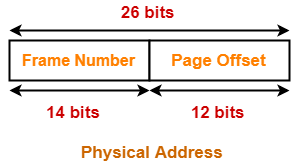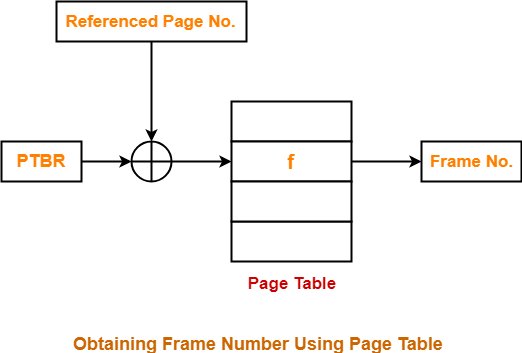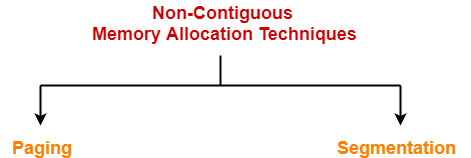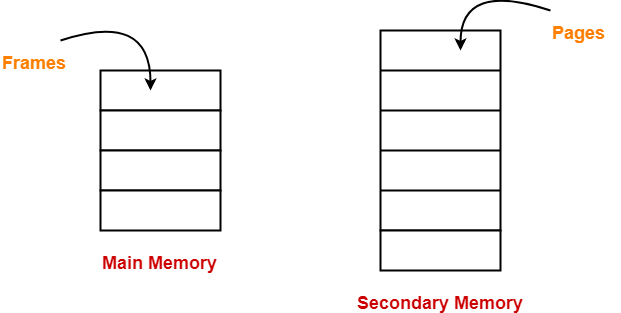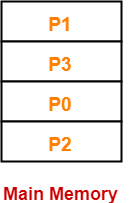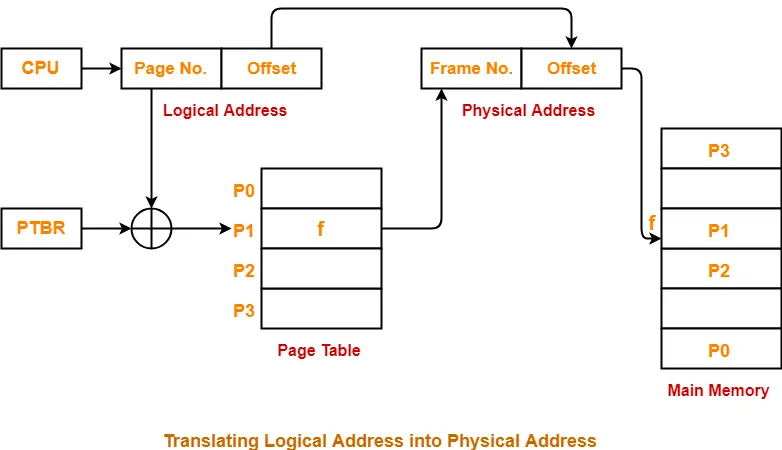Paging in OS-
Before you go through this article, make sure that you have gone through the previous article on Paging in OS.
We have discussed-
- Paging in OS is a non-contiguous memory allocation technique.
- Page Table is a data structure that maps page number to the frame number.
Disadvantage Of Paging-
One major disadvantage of paging is-
- It increases the effective access time due to increased number of memory accesses.
- One memory access is required to get the frame number from the page table.
- Another memory access is required to get the word from the page.
Translation Lookaside Buffer-
- Translation Lookaside Buffer (TLB) is a solution that tries to reduce the effective access time.
- Being a hardware, the access time of TLB is very less as compared to the main memory.
Structure-
Translation Lookaside Buffer (TLB) consists of two columns-
- Page Number
- Frame Number
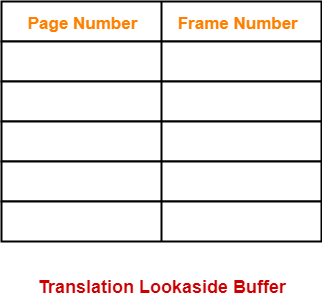
Translating Logical Address into Physical Address-
In a paging scheme using TLB,
The logical address generated by the CPU is translated into the physical address using following steps-
Step-01:
CPU generates a logical address consisting of two parts-
- Page Number
- Page Offset
Step-02:
- TLB is checked to see if it contains an entry for the referenced page number.
- The referenced page number is compared with the TLB entries all at once.
Now, two cases are possible-
Case-01: If there is a TLB hit-
- If TLB contains an entry for the referenced page number, a TLB hit occurs.
- In this case, TLB entry is used to get the corresponding frame number for the referenced page number.
Case-02: If there is a TLB miss-
- If TLB does not contain an entry for the referenced page number, a TLB miss occurs.
- In this case, page table is used to get the corresponding frame number for the referenced page number.
- Then, TLB is updated with the page number and frame number for future references.
Step-03:
- After the frame number is obtained, it is combined with the page offset to generate the physical address.
- Then, physical address is used to read the required word from the main memory.
NOTE-
In the above discussion, we have assumed that no Page Fault occurs.
Diagram-
The following diagram illustrates the above steps of translating logical address into physical address-
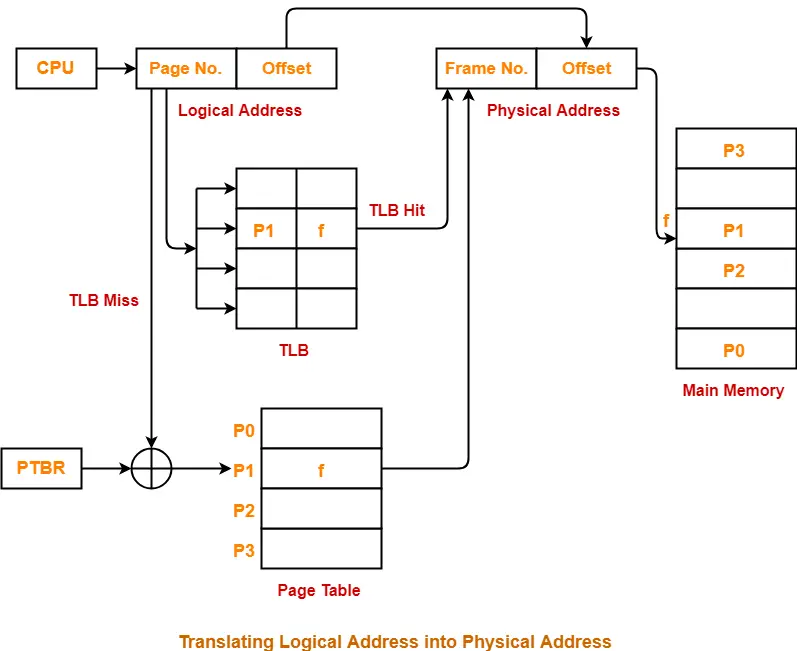
Flowchart-
The following flowchart illustrates the above steps of translating logical address into physical address-
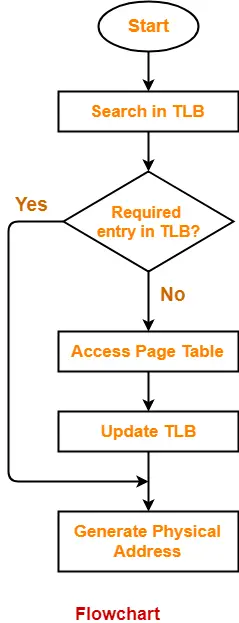
Important Points-
Point-01:
- Unlike page table, there exists only one TLB in the system.
- So, whenever context switching occurs, the entire content of TLB is flushed and deleted.
- TLB is then again updated with the currently running process.
Point-02:
When a new process gets scheduled-
- Initially, TLB is empty. So, TLB misses are frequent.
- With every access from the page table, TLB is updated.
- After some time, TLB hits increases and TLB misses reduces.
Point-03:
- The time taken to update TLB after getting the frame number from the page table is negligible.
- Also, TLB is updated in parallel while fetching the word from the main memory.
Advantages-
The advantages of using TLB are-
- TLB reduces the effective access time.
- Only one memory access is required when TLB hit occurs.
Disadvantages-
A major disadvantage of using TLB is-
- After some time of running the process, when TLB hits increases and process starts to run smoothly, a context switching occurs.
- The entire content of the TLB is flushed.
- Then, TLB is again updated with the currently running process.
This happens again and again.
Other disadvantages are-
- TLB can hold the data of only one process at a time.
- When context switches occur frequently, the performance of TLB degrades due to low hit ratio.
- As it is a special hardware, it involves additional cost.
Effective Access Time-
In a single level paging using TLB, the effective access time is given as-

This formula is valid only when there is single level paging and there are no page faults.
PRACTICE PROBLEMS BASED ON TRANSLATION LOOKASIDE BUFFER-
Problem-01:
A paging scheme uses a Translation Lookaside buffer (TLB). A TLB access takes 10 ns and a main memory access takes 50 ns. What is the effective access time (in ns) if the TLB hit ratio is 90% and there is no page fault?
- 54
- 60
- 65
- 75
Solution-
Given-
- TLB access time = 10 ns
- Main memory access time = 50 ns
- TLB Hit ratio = 90% = 0.9
Calculating TLB Miss Ratio-
TLB Miss ratio
= 1 – TLB Hit ratio
= 1 – 0.9
= 0.1
Calculating Effective Access Time-
Substituting values in the above formula, we get-
Effective Access Time
= 0.9 x { 10 ns + 50 ns } + 0.1 x { 10 ns + 2 x 50 ns }
= 0.9 x 60 ns + 0.1 x 110 ns
= 54 ns + 11 ns
= 65 ns
Thus, Option (C) is correct.
Problem-02:
A paging scheme uses a Translation Lookaside buffer (TLB). The effective memory access takes 160 ns and a main memory access takes 100 ns. What is the TLB access time (in ns) if the TLB hit ratio is 60% and there is no page fault?
- 54
- 60
- 20
- 75
Solution-
Given-
- Effective access time = 160 ns
- Main memory access time = 100 ns
- TLB Hit ratio = 60% = 0.6
Calculating TLB Miss Ratio-
TLB Miss ratio
= 1 – TLB Hit ratio
= 1 – 0.6
= 0.4
Calculating TLB Access Time-
Let TLB access time = T ns.
Substituting values in the above formula, we get-
160 ns = 0.6 x { T + 100 ns } + 0.4 x { T + 2 x 100 ns }
160 = 0.6 x T + 60 + 0.4 x T + 80
160 = T + 140
T = 160 – 140
T = 20
Thus, Option (C) is correct.
To gain better understanding about Translation Lookaside Buffer (TLB),
Next Article- Multilevel Paging
Get more notes and other study material of Operating System.
Watch video lectures by visiting our YouTube channel LearnVidFun.
